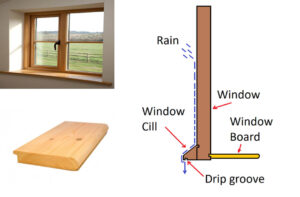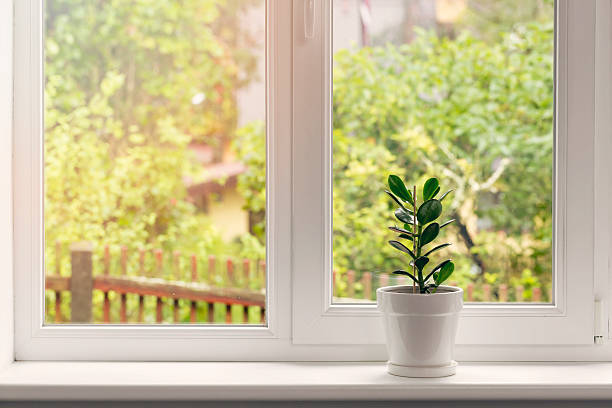When we think about a window, our minds immediately gravitate toward the view it offers, the natural light it lets in, and its role in connecting the interior to the outside world. But often overlooked is the humble window sill – a feature that serves both a functional and aesthetic purpose in the architecture of a space. Though it may seem like a small detail, the window sill plays an essential role in the overall design and utility of a room.
In this article, we will explore the significance of the window sill in architecture, its various types, materials, and how it has evolved over time.
Understanding the Window Sill
A window sill, also referred to as a windowsill, is the horizontal ledge or surface at the bottom of a window frame. It acts as a support for the window itself and provides a surface where decorative or practical items can be placed. The sill is positioned at the bottom of the window opening, extending outward from the wall, and typically has a slight incline to allow water to flow off the surface and away from the window, preventing water damage.
The function of the window sill extends beyond its utilitarian role. It adds character to the window and the overall aesthetic of a room, enhancing the beauty of a building’s interior design. In fact, many homeowners and designers use the window sill as an opportunity for creative expression, incorporating various materials, textures, and colors to complement the overall design theme.
The History and Evolution of the Window Sill
The window sill has a long history that dates back to ancient architecture. In early structures, particularly those built during the Roman and Greek periods, window sills were essential for supporting window panes and preventing water from seeping into the building. These early sills were often made of stone or wood, materials that were durable and could withstand the elements.
As architecture evolved, so did the window sill. In medieval and Renaissance buildings, window sills became more ornate, with elaborate carvings and designs that reflected the artistic movements of the time. For example, during the Gothic period, window sills were often adorned with intricate detailing and served as a focal point of the window’s design.

In the 18th and 19th centuries, the window sill became a more subtle yet functional element in architecture, especially in residential homes. During the Victorian era, window sills were typically made of wood, and many were used as display areas for plants, ornaments, and other decorative items. This practice is still common today, with homeowners placing potted plants, candles, or small knick-knacks on their window sills.
Materials Used in Window Sills
One of the most interesting aspects of the window sill is the variety of materials used to construct it. Depending on the style of the building, the climate, and the budget, different materials may be chosen for window sills. Common materials include:
- Wood: Wood is a classic choice for window sills, particularly in traditional and rustic homes. It offers a warm, natural look that complements many interior design styles. Pine, oak, and mahogany are some of the most commonly used types of wood for window sills, and they can be stained or painted to match the room’s color palette.
- Stone: For a more durable and elegant look, stone is often used for window sills, particularly in historic buildings or those with a more formal design. Marble, granite, and limestone are popular choices for stone window sills due to their ability to withstand weather conditions and add a touch of sophistication to the space.
- Concrete: In modern architecture, concrete window sills are increasingly popular for their industrial aesthetic and ability to be customized to fit any design style. Concrete can be shaped, stained, or polished to achieve different looks, from smooth and sleek to rough and textured.
- Vinyl and PVC: For a more affordable and low-maintenance option, vinyl and PVC window sills are widely used in contemporary homes. These materials are resistant to moisture and decay, making them ideal for areas with high humidity, such as bathrooms or kitchens.
- Metal: In some industrial-style or minimalist homes, metal window sills made from stainless steel or aluminum offer a sleek and modern appearance. Metal sills are durable, low-maintenance, and provide a clean, sharp look that works well in contemporary spaces.
The Role of Window Sills in Interior Design
While window sills are often viewed as a functional element, they can also serve an important role in the overall interior design of a room. Window sills offer a unique opportunity for creative expression, allowing homeowners and designers to play with color, texture, and materials to add visual interest to a space.
One common use of window sills in interior design is as a platform for decorative items. Potted plants, vases, candles, and picture frames are often placed on window sills to create a more personalized and inviting space. In some cases, window sills can even serve as a small reading nook or workspace, especially in homes with a more traditional or vintage design.
In modern homes, the window sill can also be an important part of the room’s overall layout. For example, large window sills may serve as built-in seating areas, where people can sit and enjoy the view outside. In minimalist designs, the window sill might be kept sleek and simple, emphasizing clean lines and subtle details.
The Importance of Window Sills in Home Maintenance
In addition to their aesthetic and decorative roles, window sills are also important for maintaining the structural integrity of a home. Over time, window sills can suffer from wear and tear due to exposure to the elements, particularly in homes with older windows. Water damage, rotting, and cracking are common issues that can affect window sills, especially in areas with extreme weather conditions.
Regular maintenance of window sills is essential for preventing damage and ensuring their longevity. Homeowners should periodically inspect their window sills for signs of wear, such as peeling paint, water stains, or mold growth. If necessary, the sill should be repaired or replaced to maintain the window’s functionality and appearance.
Conclusion
Though it may seem like a small and unimportant detail, the window sill is an essential element in architecture and interior design. It serves a functional purpose by supporting the window and protecting the home from water damage, but it also offers an opportunity for creative expression and design. From its historical roots to its modern applications, the window sill continues to play an important role in shaping the aesthetics and functionality of a space. Whether used as a display platform, a seating area, or a simple design feature, the window sill adds character and charm to any room.
